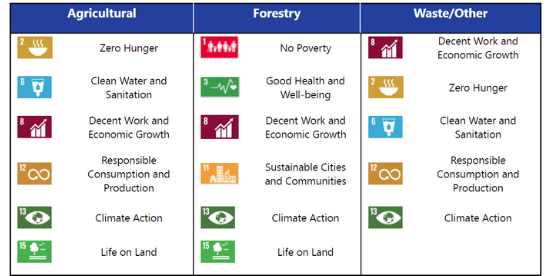How can biomass supply for bioenergy deliver multiple benefits and contribute to sustainable development goals?
Report from Joint IEA Bioenergy and GBEP Workshop held online on 15 – 16 June 2021
IEA-Bioenergy_Report-Biomass_Supply-SDGs.pdf
Scenarios that limit global warming to well below 2°C by 2050 usually rely on a significant increase in bioenergy supply to help displace carbon-intensive and fossil-based energy. An increasing demand for bioenergy will, in turn, necessitate an increase in biomass feedstock from a variety of sources.
The UN Sustainable Development Goals (SDGs) serve as a comprehensive framework to guide holistic national and international development. Such an approach is of particular interest for the sustainable production of biomass for bioenergy and other bio-based products, since biomass growth, harvesting, collection, storage, transport, processing and use can positively or negatively impact people, communities and ecosystems.
A virtual workshop was organized by IEA Bioenergy and GBEP on June 15th and 16th, 2021. The objectives of the workshop were to:
- explore the importance of the SDGs for biomass supply chains and how this relationship differs across different geographies and biomass feedstocks;
- share best practice case studies among leading experts where biomass supply chains for bioenergy have provided multiple social, economic and environmental benefits;
- explore and propose preliminary recommendations on how governance can help align biomass supply chain development with the SDGs.
This workshop report summarizes the presentations, panel discussions and workshop activities held across both days. About seventy participants from across Europe, North America, South America, Africa, Asia, and Australia registered for the workshop.
Key conclusions of the workshop discussions:
- SDGs can serve as a valuable framework in guiding the sustainable development of biomass supply chains for both bioenergy and the broader bioeconomy.
- A holistic approach to supply chain development, that also considers local factors, is essential in achieving multiple socioeconomic, cultural and environmental benefits. Solutions to implement SDGs should be flexible and consider community-level circumstances to support effective and meaningful implementation.
- Methods like strategic perennialization, land-use degradation neutrality, and biomass integration with forestry or agricultural supply chains could provide multiple benefits to local and regional ecosystems, as well as new economic opportunities for people and communities.
- A combination of supporting policies, funding, and knowledge sharing activities are important enablers for maximizing the benefits of biomass supply chains. Conversely, competing land and biomass use, limited demand and market access for feedstocks, as well as low economic viability were identified as barriers to biomass supply chain development.
- There is a need to develop governance systems that focus on the broader bioeconomy, not just bioenergy. Bioenergy is often generated as a co-product from the manufacturing of other bioproducts, so it might be more effective to consider the greater bioeconomy when using the SDGs to promote sustainable biomass supply chain development.
- Governance systems designed to support cascading supply chains, nature-based solutions and integrated land management would likely support progress towards the SDGs.
- Policy development and financial support would be needed to support further biomass supply chain development that is competitive against non-renewable energy and material alternatives.
Building on a growing body of knowledge and ongoing initiatives under IEA Bioenergy, GBEP and the Biofuture Platform, future work could investigate to what extent bioeconomy governance depends on stronger national SDG implementation, as well as assess how current bioeconomy governance systems, consisting of a more or less well integrated suite of local, regional, national and international approaches, align with the SDGs. This would help identify changes that may be required to improve existing sustainable bioeconomy governance systems, but also help to support a common understanding of sustainability using the SDGs as holistic framework through which to balance environmental, social and economic policies. Another potential area of work is the development of a toolkit on SDGs for policy makers, for example guidance material or assessment methodologies, to facilitate the review of existing bioeconomy policies or the development of new ones, to ensure sustainability across biomass supply chains upon which the bioeconomy relies.

SDGs identified as the most important to consider for each supply chain (next to SDG 7, Affordable and clean energy)


